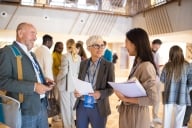You have /5 articles left.
Sign up for a free account or log in.
This year’s Society for College and University Planning conference contained a number of themes: demands for innovative classroom and group study spaces, a need to improve utilization of facilities, rising emphasis on sustainability and energy efficiency, the impact of globalization on Canadian and U.S. campuses, and, in a world of finite and, in some cases, declining resources, a need for smarter strategic planning and budgeting schemes.
But one session Wednesday -- the final day of the meeting in Montreal -- highlighted the tensions that can arise when some of those themes collide.
The session, entitled “Next Generation Learning Environments: Does One Size Fit All?”, featured an effort to build a 120-seat “theater-in-the-round”-type classroom as part of construction of a new School of Kinesiology and Health Studies Building at Ontario's Queen's University. As Janice M. Deakin, dean of graduate studies and research at Queen’s (and a kinesiologist) explained, “For us, the theater-in-the-round was already a compromise.... We would have preferred a flat surface.” But she further explained that the tiered, rounded space would accommodate typical didactic lectures, while also allowing for more interactive, collaborative pedagogical styles (her preference). Hence the compromise.
"By and large," Deakin said, "the school was sold on developing space that would allow us to do things differently" in the classroom.
Yet, ultimately, Deakin explained, the university scrapped the theater-in-the-round plans in favor of a traditional 170-seat lecture hall, each chair equipped with a tablet for writing, but too small for laptops. The reason? A university-wide (as opposed to school-specific) need for the extra 50 seats that the traditional lecture hall design could accommodate. “Teaching space belongs to the institution. Institutional need trumped our imagination,” Deakin said, explaining in an interview that Queen’s has a shortage of 150 to 200-student classrooms.
The dilemma points to bigger issues -- including the political one of who "owns" what space, and, when it comes to new campus construction, the tendency to build bigger, but for fewer students. David L. Damon, associate principal at the architecture firm Perkins+Will, explained in the presentation that the traditional lecture hall with desks leaves about 13 net square feet per student. Replace the desks with tables, and the figure jumps to 16. For the theater-in-the-round, the figure would have been about 20 net square feet per student.
Generally, increasing square footage per student is a trend in college construction, Damon explained. Academic spaces are including more areas for collaboration, and so logically take up more area. Traditional residence halls have (and this is a ballpark) about 250 square feet per bed, Damon said. New residence halls are in the 350 square feet per bed range.
Yet, as the Queen's case demonstrates, there's a tension between building more open, interactive spaces, and maximizing capacity in new construction. And, asked after the presentation about the obvious implications of building bigger for sustainability -- as is readily apparent at SCUP's conference, colleges, and the students they’re building for, care much more these days about energy efficiency -- Damon replied, “It’s a great question that clients and architects wrestle with.”
That question, he said, is part of why architects encourage the new academic spaces they’re designing -- with ample break-out and group study areas -- to be open after hours. That increases their utilization. But it also gets at university policy and security issues, Damon pointed out.
As one audience member said, "In reality, we're making 40-year-decisions in how we shape space."
SCUP’s Annual Conference ended Wednesday with a lunchtime discussion among Montreal-based architects. The conversation took as its starting point the Canadian architect Arthur Erickson’s description of the college campus as “a fragment of utopia.”
Something to think about as attendees boarded their flights home.








